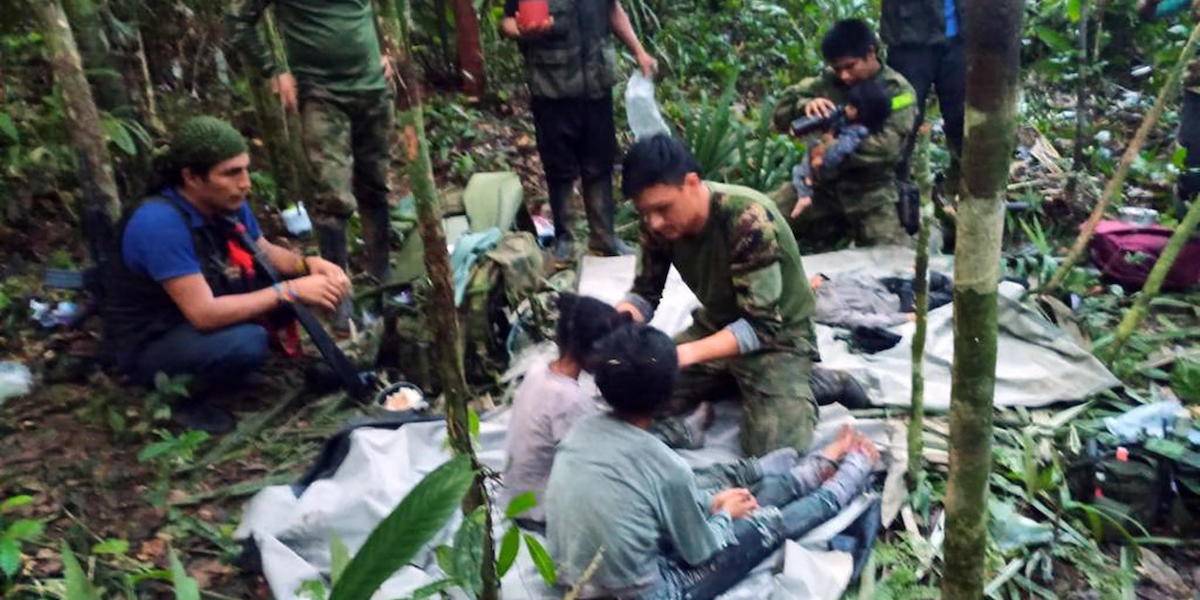The first details have emerged of how four children aged 13, 9, 5 and one year old managed to survive alone for 40 days in the Colombian rainforest after the plane crash in which they were involved. The children are brothers and sisters, they are part of the Huitoto indigenous community and their disappearance had become a case of national interest in the country: they survived in an area where snakes and jaguars live, and under heavy rains, mainly thanks to theexperience of the eldest of them, who despite her young age already knew the jungle very well and was able to orient herself in it, to avoid dangers and to know how to feed herself and her brothers in emergency situations.
Colombian President Gustavo Petro said that this story is “an example of total survival that will remain in history». The commander in charge of search operations, Pedro Sánchez, observed that if they weren’t indigenous, the chances of finding them alive would have been very low.
On May 1, Lesly Jacobombaire Mucutuy (13 years old), Soleiny Jacobombaire Mucutuy (9), Tien Ranoque Mucutuy (who has since turned 5) and Cristin Ranoque Mucutuy (1) were on board a small plane that was traveling from the center inhabited area of Araracuara, in southeast Colombia, in San José del Guaviare, in the center of the country. With them were their mother, the leader of their indigenous community and the pilot. The plane had crashed in the rainforest, more or less halfway through, due to engine failure. The wreckage was found fifteen days later, together with the bodies of the three adults.
On the other hand, there was no trace of the children, but some footprints, the remains of eaten fruit, diapers and bottles had suggested that they were still alive: they were found on Friday after intense search operations involving hundreds of people including members of the army and indigenous volunteers.
Their families and the indigenous people involved in the research explained to Colombian newspapers that after the plane crash, Lesly had built makeshift shelters with branches held together thanks to the ribbons she used to tie her hair. Initially, the girls and boys ate some cassava flour they had found in the wreckage of the plane, then they began to eat ripening wild fruits, seeds and other plants. Later they ate food that was dropped into the forest by rescue planes.
Meanwhile, from time to time they moved always to look for food and to find shelter: according to army tracings, they were found about 5 kilometers from the point where the plane had crashed. Henry Guerrero, an indigenous person who had participated in the research, he said to the journalists who had spent the last few days in a makeshift shelter made with a piece of curtain and a towel. They had a flashlight and two cell phones, but the batteries ran out pretty quickly.
The people of the Huitoto community start hunting, fishing and gathering fruit and plants from a very young age, and as explained by their grandfather, Fidencio Valencia, both Lesly and Soleiny knew the jungle very well. An uncle said that Lesly, in particular, was able to orient himself in the middle of the forest by interpreting the way the sun’s rays pass through the trees, but he also knew how to hide from dangerous animals and distinguish the practicable paths from the more risky ones , as well as which plants and mushrooms are edible and which are poisonous. Another aunt, Damarys Mucutuy, says their family often played some kind of survival game in the forest.
It is believed that in the month and a half that the girls and boys were in the jungle, they may have also had to hide from armed groups believed to live in those same forests.
Among other things, Lesly also knew how to look after a baby girl. One of the rescuers told Colombian TV RTVC that she was looking after her younger sister when the children were found. All were undernourished but fully conscious and lucid, added another rescuer.
After being rescued, the girls and boys were taken to thehospital military headquarters in Bogotá, the Colombian capital, where they are expected to remain for at least another two weeks. The doctors said they are dehydrated and cannot yet eat solid food, but Defense Minister Iván Velásquez clarified that overall they are fine and their lives are not in danger. Speaking to reporters outside the hospital, their father, Manuel Ranoque, said they survived thanks to their indigenous origins and the strong connection they have with nature.
